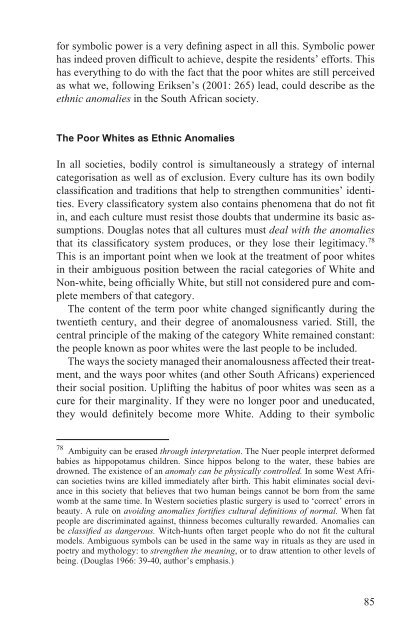The Making of a Good White - E-thesis - Helsinki.fi
The Making of a Good White - E-thesis - Helsinki.fi
The Making of a Good White - E-thesis - Helsinki.fi
Create successful ePaper yourself
Turn your PDF publications into a flip-book with our unique Google optimized e-Paper software.
for symbolic power is a very de<strong>fi</strong>ning aspect in all this. Symbolic power<br />
has indeed proven dif<strong>fi</strong>cult to achieve, despite the residents’ efforts. This<br />
has everything to do with the fact that the poor whites are still perceived<br />
as what we, following Eriksen’s (2001: 265) lead, could describe as the<br />
ethnic anomalies in the South African society.<br />
<strong>The</strong> Poor <strong>White</strong>s as Ethnic Anomalies<br />
In all societies, bodily control is simultaneously a strategy <strong>of</strong> internal<br />
categorisation as well as <strong>of</strong> exclusion. Every culture has its own bodily<br />
classi<strong>fi</strong>cation and traditions that help to strengthen communities’ identities.<br />
Every classi<strong>fi</strong>catory system also contains phenomena that do not <strong>fi</strong>t<br />
in, and each culture must resist those doubts that undermine its basic assumptions.<br />
Douglas notes that all cultures must deal with the anomalies<br />
that its classi<strong>fi</strong>catory system produces, or they lose their legitimacy. 78<br />
This is an important point when we look at the treatment <strong>of</strong> poor whites<br />
in their ambiguous position between the racial categories <strong>of</strong> <strong>White</strong> and<br />
Non-white, being <strong>of</strong><strong>fi</strong>cially <strong>White</strong>, but still not considered pure and complete<br />
members <strong>of</strong> that category.<br />
<strong>The</strong> content <strong>of</strong> the term poor white changed signi<strong>fi</strong>cantly during the<br />
twentieth century, and their degree <strong>of</strong> anomalousness varied. Still, the<br />
central principle <strong>of</strong> the making <strong>of</strong> the category <strong>White</strong> remained constant:<br />
the people known as poor whites were the last people to be included.<br />
<strong>The</strong> ways the society managed their anomalousness affected their treatment,<br />
and the ways poor whites (and other South Africans) experienced<br />
their social position. Uplifting the habitus <strong>of</strong> poor whites was seen as a<br />
cure for their marginality. If they were no longer poor and uneducated,<br />
they would de<strong>fi</strong>nitely become more <strong>White</strong>. Adding to their symbolic<br />
78 Ambiguity can be erased through interpretation. <strong>The</strong> Nuer people interpret deformed<br />
babies as hippopotamus children. Since hippos belong to the water, these babies are<br />
drowned. <strong>The</strong> existence <strong>of</strong> an anomaly can be physically controlled. In some West African<br />
societies twins are killed immediately after birth. This habit eliminates social deviance<br />
in this society that believes that two human beings cannot be born from the same<br />
womb at the same time. In Western societies plastic surgery is used to ‘correct’ errors in<br />
beauty. A rule on avoiding anomalies forti<strong>fi</strong> es cultural de<strong>fi</strong> nitions <strong>of</strong> normal. When fat<br />
people are discriminated against, thinness becomes culturally rewarded. Anomalies can<br />
be classi<strong>fi</strong> ed as dangerous. Witch-hunts <strong>of</strong>ten target people who do not <strong>fi</strong>t the cultural<br />
models. Ambiguous symbols can be used in the same way in rituals as they are used in<br />
poetry and mythology: to strengthen the meaning, or to draw attention to other levels <strong>of</strong><br />
being. (Douglas 1966: 39-40, author’s emphasis.)<br />
85
















